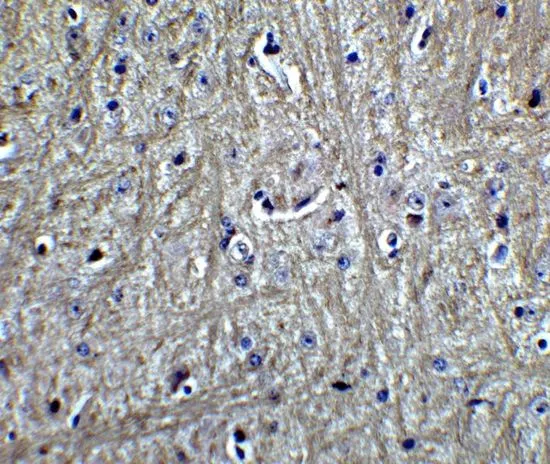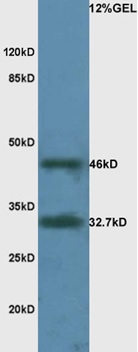![IHC-P analysis of tissue using GTX23099 RPSA antibody [MLuC5]. IHC-P analysis of tissue using GTX23099 RPSA antibody [MLuC5].](https://www.genetex.com/upload/website/prouct_img/normal/GTX23099/GTX23099_2044_IHC-P_w_23060620_611.webp)
IHC-P analysis of tissue using GTX23099 RPSA antibody [MLuC5].
RPSA antibody [MLuC5]
GTX23099
ApplicationsFlow Cytometry, ImmunoFluorescence, Western Blot, ImmunoCytoChemistry, ImmunoHistoChemistry, ImmunoHistoChemistry Frozen, ImmunoHistoChemistry Paraffin, Neutralisation/Blocking
Product group Antibodies
TargetRPSA
Overview
- SupplierGeneTex
- Product NameRPSA antibody [MLuC5]
- Delivery Days Customer9
- ApplicationsFlow Cytometry, ImmunoFluorescence, Western Blot, ImmunoCytoChemistry, ImmunoHistoChemistry, ImmunoHistoChemistry Frozen, ImmunoHistoChemistry Paraffin, Neutralisation/Blocking
- CertificationResearch Use Only
- ClonalityMonoclonal
- Clone IDMLuC5
- Concentration0.2 mg/ml
- ConjugateUnconjugated
- Gene ID3921
- Target nameRPSA
- Target descriptionribosomal protein SA
- Target synonyms37LRP, 67LR, ICAS, LAMBR, LAMR1, LBP, LBP/p40, LRP, LRP/LR, NEM/1CHD4, SA, lamR, p40, uS2, small ribosomal subunit protein uS2, 37 kDa laminin receptor, 37/67 kDa laminin receptor, 40S ribosomal protein SA, 67 kDa laminin receptor, colon carcinoma laminin-binding protein, laminin receptor 1 (67kD, ribosomal protein SA), laminin-binding protein precursor p40, multidrug resistance-associated protein MGr1-Ag
- HostMouse
- IsotypeIgM
- Protein IDP08865
- Protein NameSmall ribosomal subunit protein uS2
- Scientific DescriptionLaminins, a family of extracellular matrix glycoproteins, are the major noncollagenous constituent of basement membranes. They have been implicated in a wide variety of biological processes including cell adhesion, differentiation, migration, signaling, neurite outgrowth and metastasis. Many of the effects of laminin are mediated through interactions with cell surface receptors. These receptors include members of the integrin family, as well as non-integrin laminin-binding proteins. This gene encodes a high-affinity, non-integrin family, laminin receptor 1. This receptor has been variously called 67 kD laminin receptor, 37 kD laminin receptor precursor (37LRP) and p40 ribosome-associated protein. The amino acid sequence of laminin receptor 1 is highly conserved through evolution, suggesting a key biological function. It has been observed that the level of the laminin receptor transcript is higher in colon carcinoma tissue and lung cancer cell line than their normal counterparts. Also, there is a correlation between the upregulation of this polypeptide in cancer cells and their invasive and metastatic phenotype. Multiple copies of this gene exist, however, most of them are pseudogenes thought to have arisen from retropositional events. Two alternatively spliced transcript variants encoding the same protein have been found for this gene. [provided by RefSeq, Jul 2008]
- Storage Instruction2°C to 8°C
- UNSPSC12352203
References
- Kuriyama S, Tanaka G, Takagane K, et al. Pigment Epithelium Derived Factor Is Involved in the Late Phase of Osteosarcoma Metastasis by Increasing Extravasation and Cell-Cell Adhesion. Front Oncol. 2022,12:818182. doi: 10.3389/fonc.2022.818182Read this paper
- Piazza M, Munasinghe J, Murayi R, et al. Simulating vasogenic brain edema using chronic VEGF infusion. J Neurosurg. 2017,127(4):905-916. doi: 10.3171/2016.9.JNS1627Read this paper
- Wang ZM, Gao W, Wang H, et al. Green tea polyphenol epigallocatechin-3-gallate inhibits TNF-α-induced production of monocyte chemoattractant protein-1 in human umbilical vein endothelial cells. Cell Physiol Biochem. 2014,33(5):1349-58. doi: 10.1159/000358702Read this paper





